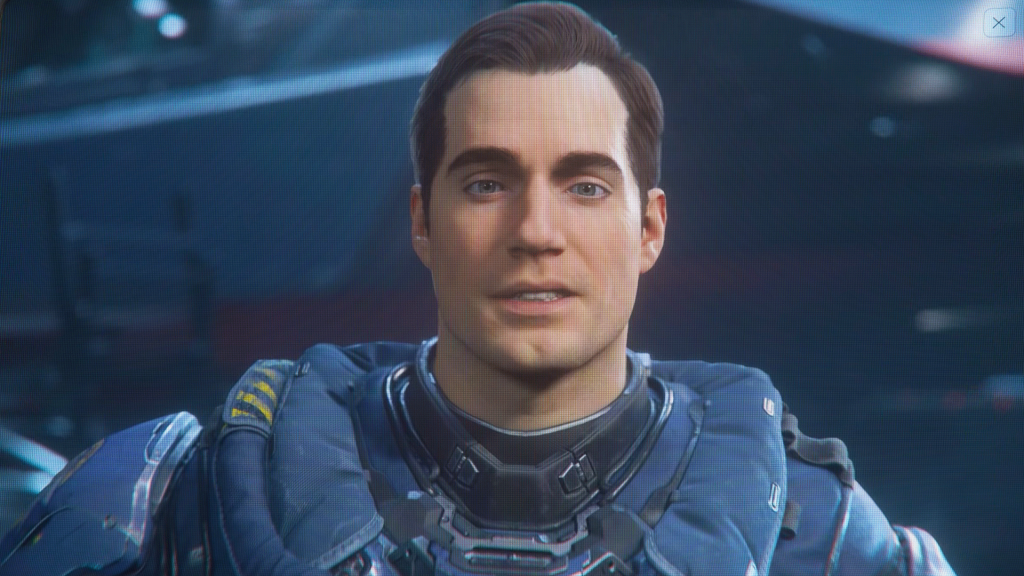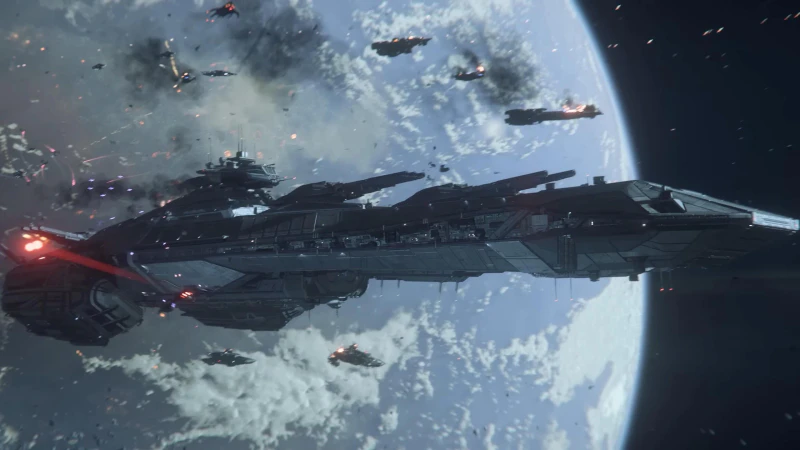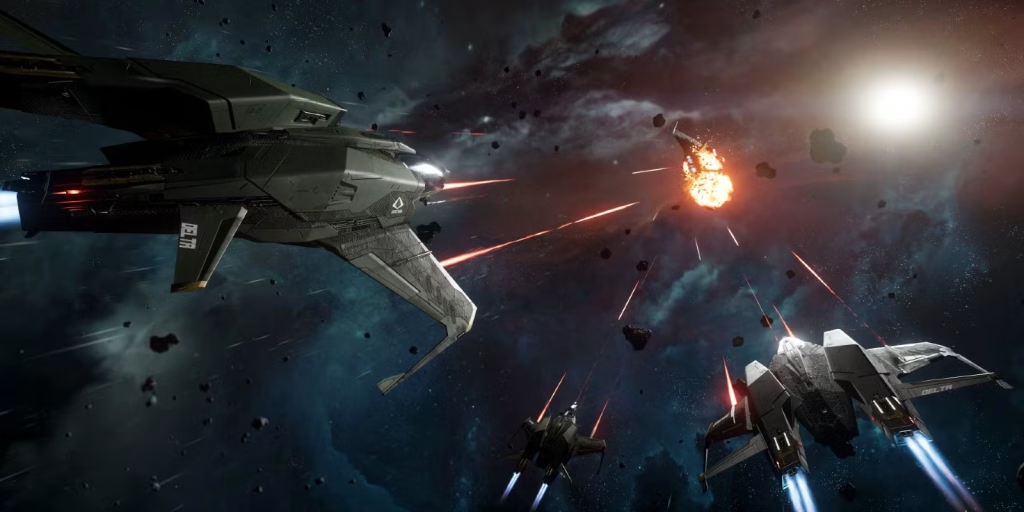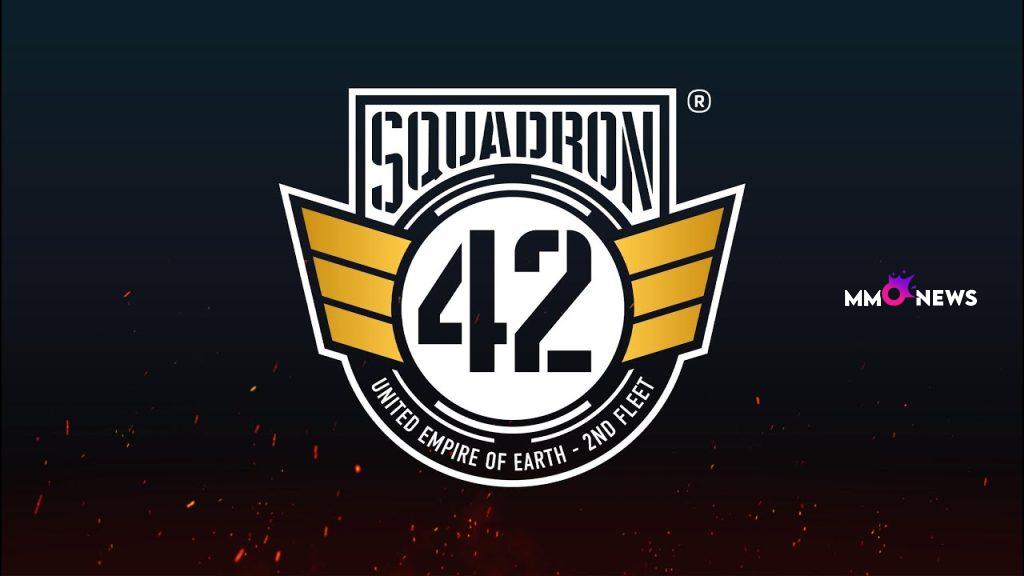The hangar hums. A carrier’s lights throw long lines across the deck as ground crew guide a flight of fighters toward the maw of space. You step into a suit that creaks like a promise and look out through glass at a sky already in motion. Squadron 42 is built for this feeling. It is a cinematic, story-driven campaign from Cloud Imperium Games that lives in the same universe as Star Citizen, but it stands on its own as a focused, character-led war story about duty, survival, and the cost of being the point of the spear.
What Squadron 42 is in plain terms
This is a single-player space combat and first-person adventure set inside the United Empire of Earth’s long conflict with hostile forces at the edge of known space. You play a rookie Navy pilot assigned to a legendary unit, climbing from the chaos of your first scramble to the slow, complicated trust of shipmates who have seen too much. Squadron 42 is designed to move with you, from cockpit to corridor to vacuum, blending dogfights, boarding actions, EVA traversal, and boots-on-the-floor missions under one camera. The tone reaches for grounded military sci-fi, anchored by real performance capture and a cast that can carry quiet scenes as well as loud ones.
Who is making it, and where it stands now
Cloud Imperium Games leads development under the Roberts Space Industries banner, with internal studios contributing across technology, cinematics, and gameplay. The game reached its feature-complete milestone in late 2023 and shifted into large-scale polish and optimization. That step was announced during CitizenCon 2953 and posted with a short developer video that set the focus on getting the feel and finish right rather than adding new systems. You can see that declaration in the official post Squadron 42 – I Held the Line, which also makes clear that the work ahead is about sanding sharp edges and tightening the whole experience rather than changing direction. The same weekend, the team reiterated the milestone in a project update roundup to set expectations about the next phase of work for the single-player campaign and the wider tech platform that powers it for both games.
The public target window points to 2026. That guidance appears on the dedicated project page and reflects the shift from building to finishing. Release timing beyond that year has not been given in detail and will be nailed down only when the team is satisfied the game plays like the story they have been showing piece by piece.
- Squadron 42 feature-complete announcement and video: Squadron 42 – I Held the Line
- Project status summary at the time of the announcement: Roadmap Roundup – October 22, 2023
- Ongoing overview and project page: Squadron 42 on the RSI site
How it connects to Star Citizen
Squadron 42 and Star Citizen share a universe, technology, and a large amount of underlying content, but they are designed for different kinds of play. The campaign is linear and authored with a beginning, middle, and end. It uses the same engine foundation and many of the same ships, locations, and systems that power Star Citizen, yet it focuses those pieces into a tight loop that can support performance-driven cinematics, curated mission pacing, and character arcs that resolve. If Star Citizen is a living simulation that grows with new systems and careers, Squadron 42 is a crafted story that asks you to live inside a specific war and come out changed by it.
The two projects feed each other. New ship behaviors, flight feel, AI advances, and material tech matured through the single-player pipeline often find a home in the persistent universe. In the other direction, improvements to streaming, physics, and netcode help the campaign by making big scenes steadier and more believable even when you are the only person in them.
The story, the cast, and the way it plays

This campaign leans on a military frame. You are a rookie assigned to the 42nd, earning your place aboard a Navy capital ship while the front shifts from quiet patrol to knives-out crisis. Life between missions is an important part of the rhythm. You will spend time on deck and inside the guts of the ship, talking to crew, picking up threads, and understanding the way a carrier breathes when it is on high alert. The performances matter here. The cast includes Gary Oldman, Henry Cavill, Mark Hamill, Gillian Anderson, Mark Strong, John Rhys-Davies, Liam Cunningham, Andy Serkis, and others, with extensive facial and body capture to keep conversations alive rather than mechanical.
Mission design aims to be seamless enough that set pieces feel earned. You will push through a scramble, match vectors under fire, take a hull peppering, then climb out through vacuum to solve a problem that a wrench and two good hands can fix faster than an order can reach engineering. Ground combat backs up the space frame without replacing it. Movement and weapon handling target weight and intent over arcade snap. Inside ships and structures, you will read rooms, use cover, and trust squad calls that come through your comms with personalities you have learned to read.
Flight, combat, and the camera that never blinks
Dogfighting pulls from the team’s experience with detailed ship simulation while staying readable to someone who is here for the story first. You will feel the mass of a loaded fighter, the strain at the edges of a turn, and the moment your co-pilot calls a lock that matters. Weapons carry identities. Cannons hit like a decision. Missiles demand timing as much as position. Defensive systems buy you seconds, and seconds are what this game trades in.
When a fight shifts to a boarding action, the camera stays with you. The transition from cockpit to corridor is part of the promise. EVA is not a cutscene; it is a space you move through with the same body and the same stakes as anywhere else. The goal is to prevent whiplash between modes, so you can remember what you were trying to do in the first place even as the frame of the world changes around you.
Ships, places, and the scale of the war

Ships are not just levels; they are characters that you will learn the way you learn people. The carrier that holds your bunk has rooms that make sense when you have walked them enough times to know where you are by smell and sound. Enemy craft carry silhouettes that tell you what they will try to do as soon as they appear on your scope. Capital ships look like cities because they are. When they fight, they do not dance. They move in ways that bend the scene around them.
Places beyond the hull get the same attention. Derelicts creak. Stations feel abandoned in ways that involve more than dust. Debris fields read like broken stories.
Technology under the hood
The project runs on the same engine foundation that powers the persistent universe, with heavy internal modification to support large-scale scenes, detailed performance capture, and seamless transitions between space and first-person encounters. The feature-complete shift moved the emphasis to performance, stability, and the kind of polish that elevates a linear experience from interesting to convincing. The notes in the 2023 roundup are a good map of that pivot, with a clean statement that the big systems are in and the work is to make them read clearly and feel responsive from start to finish. See Roadmap Roundup – October 22, 2023.
What is confirmed and what is still under wraps
Clarity helps when planning expectations.
| Confirmed | Not announced yet |
|---|---|
| Single-player cinematic campaign set in the Star Citizen universe | Exact day and month for the 2026 window |
| Feature-complete as of October 2023 and in polish | Full mission list, total campaign length, and replay features |
| Seamless flow between space, EVA, and on-foot combat | Final difficulty options and accessibility presets in detail |
| Major cast with full performance capture | Complete PC feature list at launch such as DLSS or FSR modes |
| Built by Cloud Imperium Games under the RSI banner | Hardware requirements and recommended specs |
The feel between missions
Between sorties, the carrier is the spine of the story. You will walk it with purpose. You will learn voices by the way they ask questions. The game uses that space to hold decisions and to let the tempo breathe after hard moments. This is where relationships settle or shift and where you see the human cost tallied in small ways that do not need speeches. The ship is where the next mission starts to feel inevitable instead of arbitrary.
The bridge to Star Citizen after the credits

Once the credits roll, the story you played stays its own thing. The tech, assets, and lessons feed back into Star Citizen and have already been doing so for years. That is the practical bridge. The thematic bridge is different. After spending hours inside a Navy frame with a chain of command and a ship beneath your feet, the open-ended scale of the persistent universe lands differently. The campaign will not ask you to be a different person in Star Citizen. It simply gives you another set of lenses to understand what life looks like at the sharp end of the same universe.
Release window and platforms
The current public target points to a 2026 release window on PC. The team has not provided a specific date within that year. The dedicated project page is the canonical place to watch for timing and major beats as they move from polishing to finalization and into the last run-up to launch. See Squadron 42 on the RSI site.
Why this campaign matters
Space combat games come and go. Few try to thread the needle between authored storytelling and convincing ship handling at modern fidelity. Squadron 42 is built to do that without cutting either side short. It leans on actors who can carry a scene, on mission design that trusts you to follow a thread without being told twice, and on a technology stack that can hold your attention whether the camera is pressed up against a canopy or floating past a bent bulkhead that used to be a wall.
It also matters because it respects the audience on both sides of its house. If you backed the tech because you love building worlds with friends, this campaign pushes that tech to prove it can hold pressure. If you have been waiting for a focused, single-player story with weight and craft, the studio is treating this as the place to make its case.
Closing thoughts
Squadron 42 is a promise made early and carried a long way. The team has put their stake in the ground with feature-complete status and a 2026 window, and they have framed the work ahead as the kind of polish that a story like this needs. Watch the official updates, but do not expect noise for its own sake. The best sign will be when the next look feels less like a demo and more like a finished scene that you could step into without asking where the seams are.
